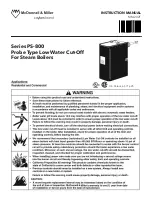
50
5. REASSEMBLE BOILER
CAUTION
Do not start the burner unless canopy, smokepipe,
burner mounting plate and all flue plates are
secured in place.
a. If removed, install the canopy taking care to
align the cerafelt strips. If strips are damaged
replace as needed.
b. Reinstall burner mounting plate to front section
making sure 3/16” diameter rope gasket is in
place and forms gas tight seal. If gasket is
damaged, replace.
c. Bolt burner to burner mounting plate. Inspect
gasket to assure adequate seal. Replace if
damaged. Connect oil line(s) and/or gas line(s).
d. Reinstall flue plates making sure gasket on each
plate is in place and forms gas tight seal. If
damaged, all edges of the cleanout plates should
be sealed with Silastic sealant when reinstalled
until insulation can be replaced.
e. If removed, reinstall jacket top.
f. Reinstall left side panels.
g. Reinstall smokepipe.
C.
MAINTENANCE OF LOW WATER CUTOFF
DEVICES.
NOTICE
Probe and float type low water cutoff devices
require annual inspection and maintenance.
1. PROBE TYPE LOW WATER CUTOFF
Although these devices are solid state in their
operation, the probe is exposed to possible
contamination in the boiler water and subject to
fouling.
It is important to physically remove the probe from
the boiler tapping annually and inspect that probe
for accumulation of scale or sediment.
Follow these steps to inspect, clean and/or replace
the probe:
a. Turn off electric service to the boiler.
b. Drain boiler water to a level below the tapping
for the probe.
DANGER
Assure that the boiler is at zero pressure before
removing the LWCO probe. Do not rely on the
pressure gauge to indicate that the boiler is at
zero pressure. Open the safety valve to relieve
all internal pressure prior to proceeding. Safety
valve discharge piping must be piped such that
the potential for burns is eliminated.
c. Disconnect wiring connections between the low
water cutoff control and the probe.
d. Dismount the low water cutoff control from the
probe.
e. Unscrew the probe from the boiler tapping.
f. Inspect that portion of the probe that is exposed
to the boiler water for a scale or sediment
buildup.
g. Light deposits may be removed by wiping the
probe with a damp cloth. Wiping the probe
with a cloth soaked in vinegar will remove more
tenacious lime deposits. The most stubborn
deposits may be removed from the probe by
using a diluted amount (three 3 parts of water to
one (1) part) of phosphoric acid (H2PO4).
WARNING
Exercise caution when handling phosphoric acid
and follow the instructions on container label.
Always use protective clothing and equipment
when working with/near chemicals.
h. Wire brushing of the probe is not recommended
as the soft platinum guard ring sandwiched
between the ceramic insulators may be damaged.
Care must be taken not to damage this ring in
any way or the useful life of the probe may be
shortened.
i. Clean the pipe threads of the probe to remove
old, hardened pipe dope and other foreign matter.
j. Apply a moderate amount of good quality pipe
dope to the pipe threads on the probe. Leaving
the two end threads bare. Do not use PTFE
(Teflon) tape.
k. Screw the probe into the boiler tapping.
l. Mount the low water cutoff control on the probe.
m. Reconnect the control to probe wiring.
n. Fill the boiler to its normal waterline.
o. Add boiler water treatment compound as needed.
p. Restore electric service to the boiler.
q. Fire burner to bring the water in the boiler to a
boil to drive off free oxygen.
r. BEFORE RETURNING BOILER TO
SERVICE Follow the low water cutoff checkout
procedure in Section IV, Paragraph E, Step 3.
2. FLOAT TYPE LOW WATER CUTOFF
During the heating season, if an external low water
cutoff is on the boiler, the blow off valve should
be opened once a month (use greater frequency
where conditions warrant), to flush out the sediment
chamber so the device will be free to function
properly.
Low water cutoffs and water feeders should be
dismantled annually by qualified personnel, to the
extent necessary to insure freedom from obstructions
Summary of Contents for operating and
Page 2: ...2 ...
Page 8: ...8 Section I General Information Figure 1 Dimensional Information ...
Page 21: ...21 Figure 16 Bare Boiler Assembly ...
Page 25: ...25 Figure 22 V9A Series Jacket Assembly Boiler Models V903A thru V912A ...
Page 31: ...31 Figure 26 V9A Series Minimum Piping Parallel Water Boiler ...
Page 32: ...32 Figure 27 V9A Series Minimum Piping Primary Secondary Water Boiler ...
Page 33: ...33 Figure 28 V9A Series Minimum Piping Details Bypass with Blend Pump Water Boiler ...
Page 34: ...34 Figure 29 V9A Series Minimum Piping Primary Secondary with Bypass Water Boiler ...
Page 37: ...37 Figure 32 Minimum Piping Requirements For Gravity Return V9A Series Steam Boilers ...
Page 42: ...42 Figure 37b DHW Generation with Tankless Coils Storage Tank and Destratification Pump ...
Page 43: ...43 Figure 37c DHW Generation with Indirect Water Heater ...
Page 58: ...58 Figure 40 Bare Boiler Assembly ...
Page 62: ...62 SERVICE RECORD DATE SERVICE PERFORMED ...
Page 63: ...63 SERVICE RECORD DATE SERVICE PERFORMED ...
Page 64: ...64 ...















































